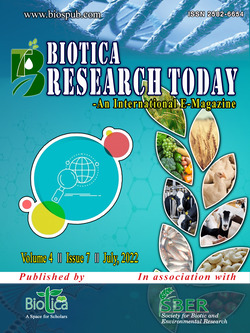
Hedge Lucerne as a Proteinaceous Feed for Livestock Production
R. Sathya Priya*
Dept. of Agronomy, Directorate of Crop Management, Tamil Nadu Agricultural University, Coimbatore, Tamil Nadu (641 003), India
N. Jagathjothi
Dept. of Agronomy, Directorate of Crop Management, Tamil Nadu Agricultural University, Coimbatore, Tamil Nadu (641 003), India
R. Kuttimani
Dept. of Agronomy, Directorate of Crop Management, Tamil Nadu Agricultural University, Coimbatore, Tamil Nadu (641 003), India
DOI: NIL
Keywords: Fodder, N-fixing legume, Protein rich, Soil fertility
Abstract
Leguminous shrub, hedge lucerne [(Desmanthus virgatus (L.) Willd.] has been projected as an alternative plant protein feed ingredient to the expensive soybean meal commonly used in livestock diets. It is commonly known as hedge lucerne, donkey bean or desmanthus. Productivity of farm animals in most tropical countries is generally low, mainly due to poor quality and inadequacy of available feeds. In this situation hedge lucerne represents a positive alternative to other more expensive feeds, as the plant can be easily grown on a wide range of soil types or climates and readily harvested, dried and processed for use as a protein rich meal supplement in livestock diets. It is one of good green fodder to goat, sheep, cow, rabbit and poultry. Finally, it also increases the weight gain, improves productivity of milk and replaces the 50% of concentrate feed in diet of livestock.
Downloads
not found
Reference
FAO, 2010. Grassland Index. A searchable catalogue of grass and forage legumes. FAO, Rome, Italy, pp. 14-17.
Keoghan, J.M., 1980. Adaptable and productive forage legumes and grasses for more intensive small ruminant livestock systems in the Caribbean. Tropical Animal Production 5(1), 8-14.
Radhakrishnan, L., Murugan, M., Sivakumar, T., 2007. Biomass yield, chemical composition and nutritive value of Desmanthus virgatus (hedge lucerne) for sheep. Animal Nutrition Feed Technology 7(1), 119-123.
Ramirez, R.G., Haenlein, G.F.W., Nunez-Gonzalez, M.A., 2001. Seasonal variation of macro and trace mineral contents in 14 browse species that grow in north-eastern Mexico. Small Ruminants Research 39(2), 153-159.
Rangel, J.H., Gardiner, C.P., 2009. Stimulation of wool growth by Desmanthus spp. as a supplement to a diet of Mitchell grass hay. Tropical Grasslands 43(2), 106-111.
